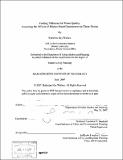Trading pollution for water quality : assessing the effects of market-based instruments in three basins
Author(s)
Wallace, Katherine Hay
DownloadFull printable version (11.47Mb)
Other Contributors
Massachusetts Institute of Technology. Dept. of Urban Studies and Planning.
Advisor
Lawrence E. Susskind.
Terms of use
Metadata
Show full item recordAbstract
Since its passage in 1972, the majority of pollution reduction under the federal Clean Water Act has resulted from technology-based limits imposed on point source dischargers. However, most U.S. water bodies are unmonitored and of those that are, between 40 and 50 percent remain impaired. Given this limited progress, the U.S. Environmental Protection Agency, multiple state agencies, and non-governmental organizations have proposed water quality trading as a cost-effective means to achieve pollution reductions from point and nonpoint sources. To determine whether these programs actually achieve cost-effective pollution reduction in practice that they promise in theory, I evaluate direct and indirect outcomes associated with three water quality trading cases: the Grassland Area Farmers Tradable Loads Program in California's San Joaquin Valley; the Tar-Pamlico River Basin Nutrient Offset Program in North Carolina; and the Long Island Sound Nitrogen Credit Exchange in Connecticut. Although reallocating reduction efforts through trades to achieve cost-effective solutions is supposedly the major benefit of market-based instruments, only dischargers in the Long Island Sound Nitrogen Credit Exchange actively traded. (cont.) The Grassland Area Farmers abandoned trading in favor of a more affordable and heavily subsidized management strategy, and members of the Tar-Pamlico Basin Association removed pollution onsite because reductions were less costly than expected and uncertainty over Offset Program parameters impeded planning around trades. Dischargers in the two cases also hesitated to trade because political transaction costs that trading imposed on relationships among entities did not outweigh perceived savings. Connecticut mitigated these costs and uncertainty by administering the Nitrogen Credit Exchange. The major contributions of market-based instruments across cases were facilitating dischargers' willingness to accept more stringent regulations and increasing the institutional capacity for watershed management by encouraging formation of organizations along hydrologic boundaries and information collection and dissemination. These benefits are attributable to the decentralized governance structure in general rather than economic incentives specifically, suggesting that policymakers should consider other decentralized approaches to watershed management. (cont.) If policymakers want dischargers to actively trade, they should design parameters that mitigate uncertainty, market distortions, and political transaction costs. Even if trades never occur, however, indirect outcomes associated with market-based instruments are significant given the ongoing challenges to water quality improvement under the Clean Water Act.
Description
Thesis (M.C.P.)--Massachusetts Institute of Technology, Dept. of Urban Studies and Planning, 2007. Includes bibliographical references (p. 83-90).
Date issued
2007Department
Massachusetts Institute of Technology. Department of Urban Studies and PlanningPublisher
Massachusetts Institute of Technology
Keywords
Urban Studies and Planning.